Yajie Zhao
Learning an Implicit Physics Model for Image-based Fluid Simulation
Aug 11, 2025Abstract:Humans possess an exceptional ability to imagine 4D scenes, encompassing both motion and 3D geometry, from a single still image. This ability is rooted in our accumulated observations of similar scenes and an intuitive understanding of physics. In this paper, we aim to replicate this capacity in neural networks, specifically focusing on natural fluid imagery. Existing methods for this task typically employ simplistic 2D motion estimators to animate the image, leading to motion predictions that often defy physical principles, resulting in unrealistic animations. Our approach introduces a novel method for generating 4D scenes with physics-consistent animation from a single image. We propose the use of a physics-informed neural network that predicts motion for each surface point, guided by a loss term derived from fundamental physical principles, including the Navier-Stokes equations. To capture appearance, we predict feature-based 3D Gaussians from the input image and its estimated depth, which are then animated using the predicted motions and rendered from any desired camera perspective. Experimental results highlight the effectiveness of our method in producing physically plausible animations, showcasing significant performance improvements over existing methods. Our project page is https://physfluid.github.io/ .
FVGen: Accelerating Novel-View Synthesis with Adversarial Video Diffusion Distillation
Aug 08, 2025Abstract:Recent progress in 3D reconstruction has enabled realistic 3D models from dense image captures, yet challenges persist with sparse views, often leading to artifacts in unseen areas. Recent works leverage Video Diffusion Models (VDMs) to generate dense observations, filling the gaps when only sparse views are available for 3D reconstruction tasks. A significant limitation of these methods is their slow sampling speed when using VDMs. In this paper, we present FVGen, a novel framework that addresses this challenge by enabling fast novel view synthesis using VDMs in as few as four sampling steps. We propose a novel video diffusion model distillation method that distills a multi-step denoising teacher model into a few-step denoising student model using Generative Adversarial Networks (GANs) and softened reverse KL-divergence minimization. Extensive experiments on real-world datasets show that, compared to previous works, our framework generates the same number of novel views with similar (or even better) visual quality while reducing sampling time by more than 90%. FVGen significantly improves time efficiency for downstream reconstruction tasks, particularly when working with sparse input views (more than 2) where pre-trained VDMs need to be run multiple times to achieve better spatial coverage.
RDD: Robust Feature Detector and Descriptor using Deformable Transformer
May 12, 2025Abstract:As a core step in structure-from-motion and SLAM, robust feature detection and description under challenging scenarios such as significant viewpoint changes remain unresolved despite their ubiquity. While recent works have identified the importance of local features in modeling geometric transformations, these methods fail to learn the visual cues present in long-range relationships. We present Robust Deformable Detector (RDD), a novel and robust keypoint detector/descriptor leveraging the deformable transformer, which captures global context and geometric invariance through deformable self-attention mechanisms. Specifically, we observed that deformable attention focuses on key locations, effectively reducing the search space complexity and modeling the geometric invariance. Furthermore, we collected an Air-to-Ground dataset for training in addition to the standard MegaDepth dataset. Our proposed method outperforms all state-of-the-art keypoint detection/description methods in sparse matching tasks and is also capable of semi-dense matching. To ensure comprehensive evaluation, we introduce two challenging benchmarks: one emphasizing large viewpoint and scale variations, and the other being an Air-to-Ground benchmark -- an evaluation setting that has recently gaining popularity for 3D reconstruction across different altitudes.
Bringing Diversity from Diffusion Models to Semantic-Guided Face Asset Generation
Apr 21, 2025Abstract:Digital modeling and reconstruction of human faces serve various applications. However, its availability is often hindered by the requirements of data capturing devices, manual labor, and suitable actors. This situation restricts the diversity, expressiveness, and control over the resulting models. This work aims to demonstrate that a semantically controllable generative network can provide enhanced control over the digital face modeling process. To enhance diversity beyond the limited human faces scanned in a controlled setting, we introduce a novel data generation pipeline that creates a high-quality 3D face database using a pre-trained diffusion model. Our proposed normalization module converts synthesized data from the diffusion model into high-quality scanned data. Using the 44,000 face models we obtained, we further developed an efficient GAN-based generator. This generator accepts semantic attributes as input, and generates geometry and albedo. It also allows continuous post-editing of attributes in the latent space. Our asset refinement component subsequently creates physically-based facial assets. We introduce a comprehensive system designed for creating and editing high-quality face assets. Our proposed model has undergone extensive experiment, comparison and evaluation. We also integrate everything into a web-based interactive tool. We aim to make this tool publicly available with the release of the paper.
SC-OmniGS: Self-Calibrating Omnidirectional Gaussian Splatting
Feb 07, 2025



Abstract:360-degree cameras streamline data collection for radiance field 3D reconstruction by capturing comprehensive scene data. However, traditional radiance field methods do not address the specific challenges inherent to 360-degree images. We present SC-OmniGS, a novel self-calibrating omnidirectional Gaussian splatting system for fast and accurate omnidirectional radiance field reconstruction using 360-degree images. Rather than converting 360-degree images to cube maps and performing perspective image calibration, we treat 360-degree images as a whole sphere and derive a mathematical framework that enables direct omnidirectional camera pose calibration accompanied by 3D Gaussians optimization. Furthermore, we introduce a differentiable omnidirectional camera model in order to rectify the distortion of real-world data for performance enhancement. Overall, the omnidirectional camera intrinsic model, extrinsic poses, and 3D Gaussians are jointly optimized by minimizing weighted spherical photometric loss. Extensive experiments have demonstrated that our proposed SC-OmniGS is able to recover a high-quality radiance field from noisy camera poses or even no pose prior in challenging scenarios characterized by wide baselines and non-object-centric configurations. The noticeable performance gain in the real-world dataset captured by consumer-grade omnidirectional cameras verifies the effectiveness of our general omnidirectional camera model in reducing the distortion of 360-degree images.
Acquisition of Spatially-Varying Reflectance and Surface Normals via Polarized Reflectance Fields
Dec 13, 2024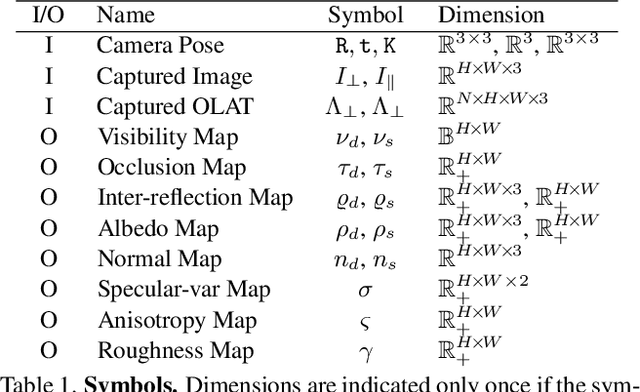
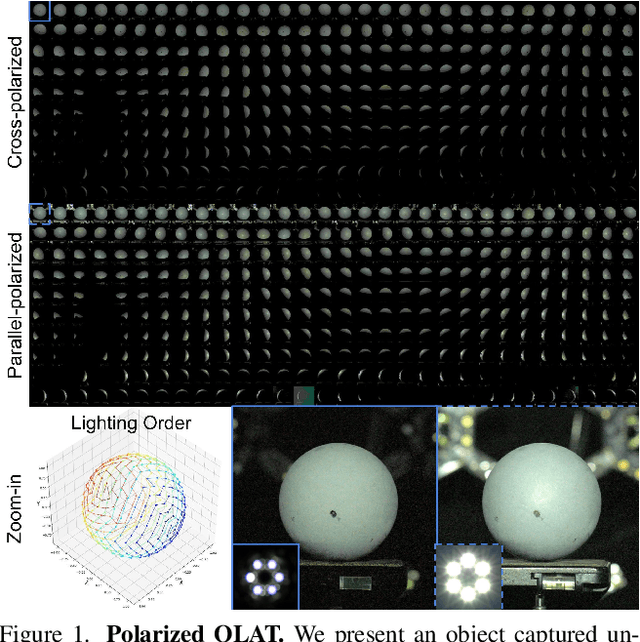
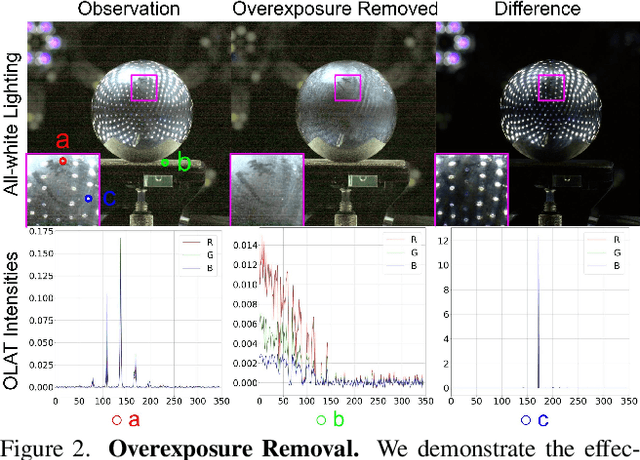
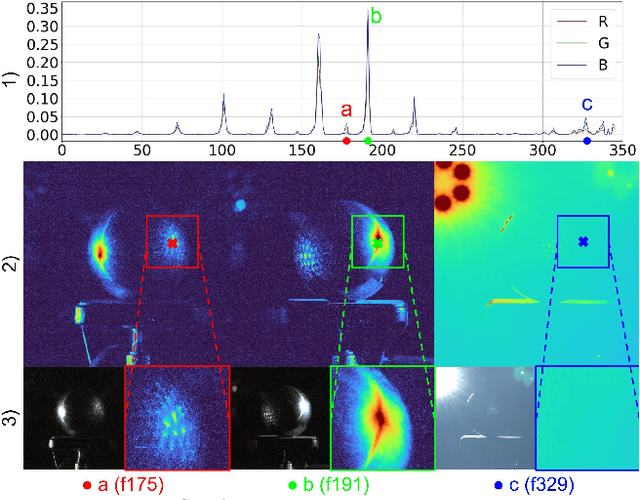
Abstract:Accurately measuring the geometry and spatially-varying reflectance of real-world objects is a complex task due to their intricate shapes formed by concave features, hollow engravings and diverse surfaces, resulting in inter-reflection and occlusion when photographed. Moreover, issues like lens flare and overexposure can arise from interference from secondary reflections and limitations of hardware even in professional studios. In this paper, we propose a novel approach using polarized reflectance field capture and a comprehensive statistical analysis algorithm to obtain highly accurate surface normals (within 0.1mm/px) and spatially-varying reflectance data, including albedo, specular separation, roughness, and anisotropy parameters for realistic rendering and analysis. Our algorithm removes image artifacts via analytical modeling and further employs both an initial step and an optimization step computed on the whole image collection to further enhance the precision of per-pixel surface reflectance and normal measurement. We showcase the captured shapes and reflectance of diverse objects with a wide material range, spanning from highly diffuse to highly glossy - a challenge unaddressed by prior techniques. Our approach enhances downstream applications by offering precise measurements for realistic rendering and provides a valuable training dataset for emerging research in inverse rendering. We will release the polarized reflectance fields of several captured objects with this work.
Skyeyes: Ground Roaming using Aerial View Images
Sep 25, 2024

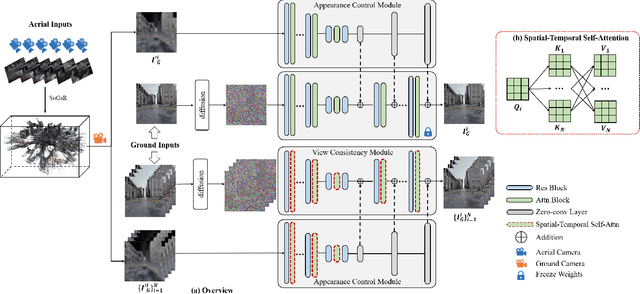

Abstract:Integrating aerial imagery-based scene generation into applications like autonomous driving and gaming enhances realism in 3D environments, but challenges remain in creating detailed content for occluded areas and ensuring real-time, consistent rendering. In this paper, we introduce Skyeyes, a novel framework that can generate photorealistic sequences of ground view images using only aerial view inputs, thereby creating a ground roaming experience. More specifically, we combine a 3D representation with a view consistent generation model, which ensures coherence between generated images. This method allows for the creation of geometrically consistent ground view images, even with large view gaps. The images maintain improved spatial-temporal coherence and realism, enhancing scene comprehension and visualization from aerial perspectives. To the best of our knowledge, there are no publicly available datasets that contain pairwise geo-aligned aerial and ground view imagery. Therefore, we build a large, synthetic, and geo-aligned dataset using Unreal Engine. Both qualitative and quantitative analyses on this synthetic dataset display superior results compared to other leading synthesis approaches. See the project page for more results: https://chaoren2357.github.io/website-skyeyes/.
Geometry-aware Feature Matching for Large-Scale Structure from Motion
Sep 03, 2024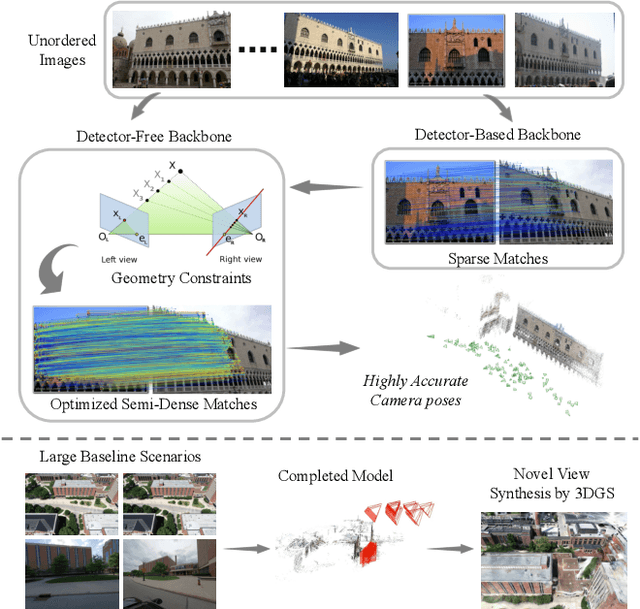
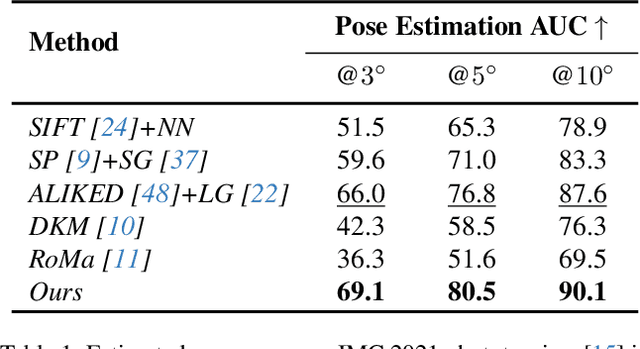
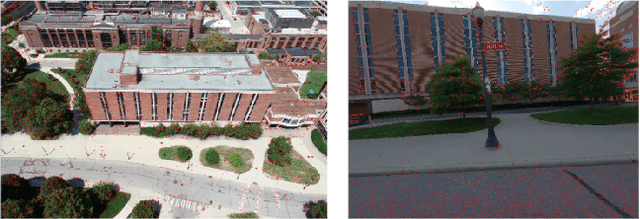
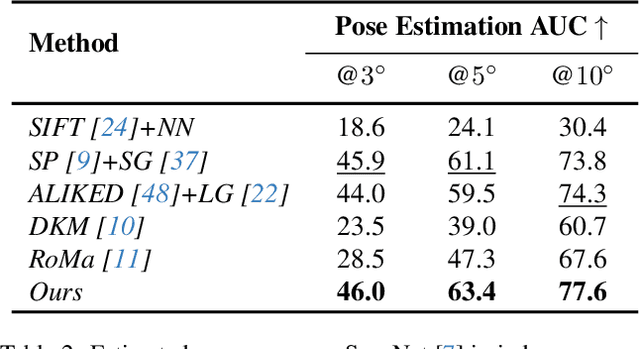
Abstract:Establishing consistent and dense correspondences across multiple images is crucial for Structure from Motion (SfM) systems. Significant view changes, such as air-to-ground with very sparse view overlap, pose an even greater challenge to the correspondence solvers. We present a novel optimization-based approach that significantly enhances existing feature matching methods by introducing geometry cues in addition to color cues. This helps fill gaps when there is less overlap in large-scale scenarios. Our method formulates geometric verification as an optimization problem, guiding feature matching within detector-free methods and using sparse correspondences from detector-based methods as anchor points. By enforcing geometric constraints via the Sampson Distance, our approach ensures that the denser correspondences from detector-free methods are geometrically consistent and more accurate. This hybrid strategy significantly improves correspondence density and accuracy, mitigates multi-view inconsistencies, and leads to notable advancements in camera pose accuracy and point cloud density. It outperforms state-of-the-art feature matching methods on benchmark datasets and enables feature matching in challenging extreme large-scale settings.
Localized Gaussian Splatting Editing with Contextual Awareness
Jul 31, 2024



Abstract:Recent text-guided generation of individual 3D object has achieved great success using diffusion priors. However, these methods are not suitable for object insertion and replacement tasks as they do not consider the background, leading to illumination mismatches within the environment. To bridge the gap, we introduce an illumination-aware 3D scene editing pipeline for 3D Gaussian Splatting (3DGS) representation. Our key observation is that inpainting by the state-of-the-art conditional 2D diffusion model is consistent with background in lighting. To leverage the prior knowledge from the well-trained diffusion models for 3D object generation, our approach employs a coarse-to-fine objection optimization pipeline with inpainted views. In the first coarse step, we achieve image-to-3D lifting given an ideal inpainted view. The process employs 3D-aware diffusion prior from a view-conditioned diffusion model, which preserves illumination present in the conditioning image. To acquire an ideal inpainted image, we introduce an Anchor View Proposal (AVP) algorithm to find a single view that best represents the scene illumination in target region. In the second Texture Enhancement step, we introduce a novel Depth-guided Inpainting Score Distillation Sampling (DI-SDS), which enhances geometry and texture details with the inpainting diffusion prior, beyond the scope of the 3D-aware diffusion prior knowledge in the first coarse step. DI-SDS not only provides fine-grained texture enhancement, but also urges optimization to respect scene lighting. Our approach efficiently achieves local editing with global illumination consistency without explicitly modeling light transport. We demonstrate robustness of our method by evaluating editing in real scenes containing explicit highlight and shadows, and compare against the state-of-the-art text-to-3D editing methods.
Don't Look into the Dark: Latent Codes for Pluralistic Image Inpainting
Mar 27, 2024

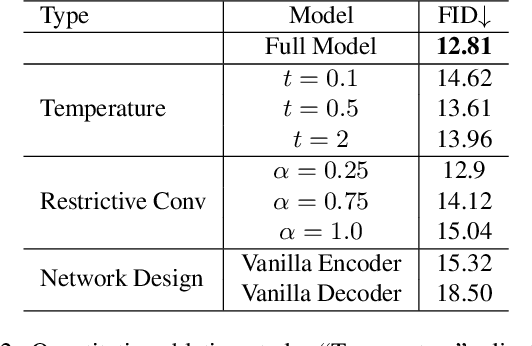
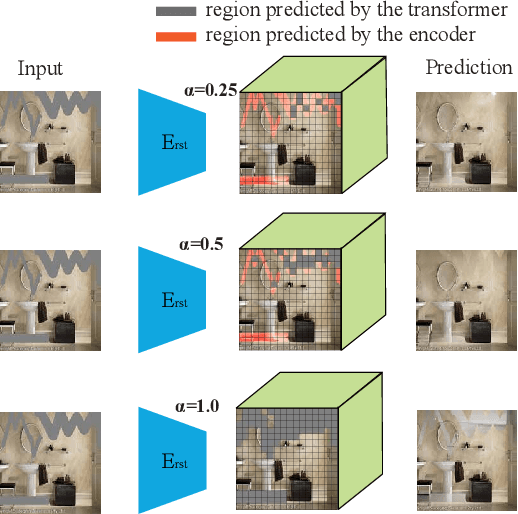
Abstract:We present a method for large-mask pluralistic image inpainting based on the generative framework of discrete latent codes. Our method learns latent priors, discretized as tokens, by only performing computations at the visible locations of the image. This is realized by a restrictive partial encoder that predicts the token label for each visible block, a bidirectional transformer that infers the missing labels by only looking at these tokens, and a dedicated synthesis network that couples the tokens with the partial image priors to generate coherent and pluralistic complete image even under extreme mask settings. Experiments on public benchmarks validate our design choices as the proposed method outperforms strong baselines in both visual quality and diversity metrics.
 Add to Chrome
Add to Chrome Add to Firefox
Add to Firefox Add to Edge
Add to Edge